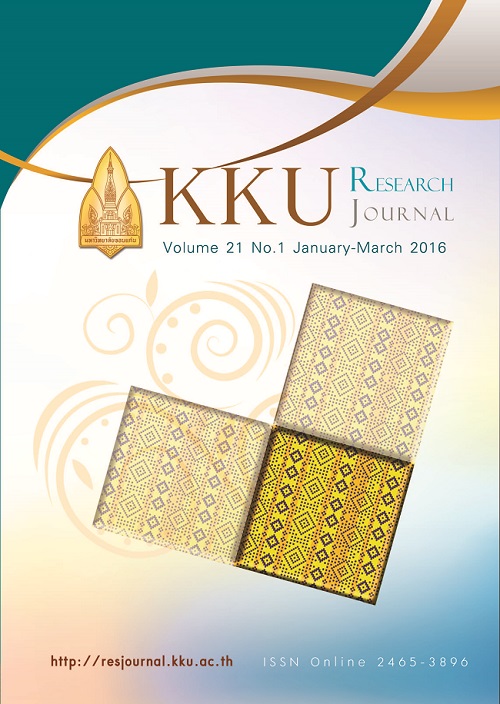Biodiversity of fungi in seawater and sediment from mangrove forest at Andaman coastal research station for development, Ranong province
Main Article Content
Abstract
Fungal diversity in the seawater and sediment in the mangrove forest at Andaman Coastal Research Station for Development, Ranong Province was studied. Seawater and sediment were sampled in 5 sites during the rainy and dry season. The fungi were cultivated in Potato Dextrose Agar (PDA) supplemented with Streptomycin and Chloramphenical and incubated at room temperature for 7 days. Eighty nine and 99 fungal isolates were found in the sediment and seawater samples, respectively. Fungal identification was done using their molecular study. Forty-five fungal species could be identified using molecular study and morphological features including: Acremonium furcatum, A. nepalense, Aspergillus aculeatus, A. flavus,
A. fumigatus, A. niger, A. nomius, A. nutans, A. oryzae, A. tubingensis, Aspergillus sp., Ceratocystis paradoxa, Cladosporium cladosporioides,
C. oxysporum, Colletotrichum gloeosporioides, Diaporthe helianthi,
Didymellaceae sp., Dothideomycetes sp., Eupenicillium shearii, Fusarium equiseti, F. moniliformis, F. nelsonii, F. oxysporum, F. proliferatum, F. solani,
F. subglutinans, Fusarium sp., Ganoderma cupreum, Gliocephalotrichum simplex, Gongronella butleri, Hypocrea jecorina, Lasiodiplodia theobromae, Neosartorya fischeri, Penicillium citrinum, P. funiculosum, P. griseofulvum, P. janthinellum,
P. lilacinum, P. oxalicum, P. rademirici, P. simplicissimum, P. stecki, P. vasconiae, Penicillium sp., Pestalotiopsis mangiferae, Pleurotus pulmonarius, Rigidoporus vinctus, Sordaria sp., Talaromyces assiutensis, Trichaptum laricinum, Trichoderma asperellum, Trichoderma sp. and Xylaria apoda. The common fungal species found in this study were Penicillium, Aspergillus and Fusarium.
Article Details
References
apiculata and A. alba at Thachine estuary SamutSakhon Province [PhD thesis]. Bangkok: Kasatsart
University; 2001.
[2] Kohlmeyer J, Kohlmeyer E. Marine mycology. The higher fungi.Academic Press. New York; 1979.
[3] Aksornkoae S. Mangrove ecology and management. 2nd ed. Kasetsart University: Bangkok; 1998.
[4] Hawksworth DL. The fungal dimension of biodiversity:magnitude, significance and
conservation. Mycological Research. 1991; 95: 641-655.
[5] L e i g h t l e y L E , E a t o n R A .Mechanisms of decay of timber by aquatic micro-organisms. Rec. Ann.
Conv. Br. Wood Preserv. Assoc;1977: p.1-26.
[6] Pisano MA, Mihalik LA, Cataland GR. Gelatinase activity by marine fungi. Applied Microbiology. 1964;12: 470-474.
[7] Peters KE, Sweeney RE, Kaplan IR.Correlation of carbon and nitrogen stable isotopes in sedimentary organic matter. Limnol. Oceanogr.1978; 23: 598-604.
[8] Block JH, Catalfomo P, Contantine GH, Kirk PW. Triglyceride fatty acids of selected higher marine
fungi. Mycologia. 1973; 65:448-451.
[9] Catalfomo P, Block, Constantine GH, Kirk PW. Choline sulfate(ester) in marine higher fungi. Mar Chem. 1973; 95: 641-655.
[10] Murray HG, Thompson WF. Rapid isolation of high molecular weight DNA. Nucleic Acids Res.1980;8:4321-4325.


